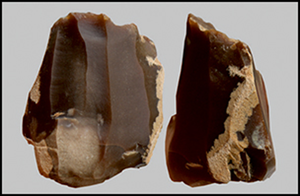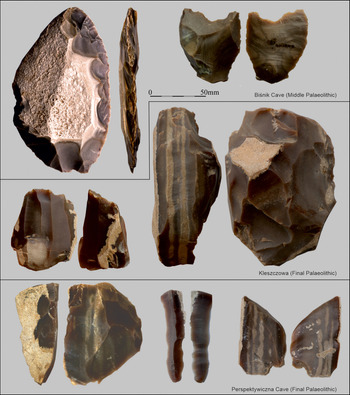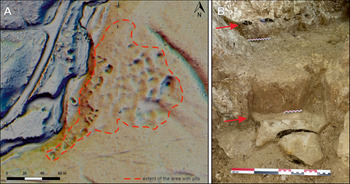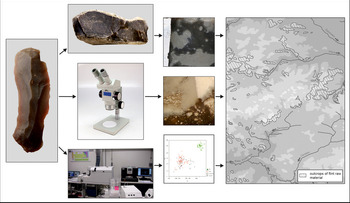Chocolate flint
Among many varieties of siliceous rocks that were used as a raw material in the territory of Poland, chocolate flint stands out both technically and visually (Figure 1). Chocolate flint has been the focus of research for almost 100 years (e.g. Krukowski Reference Krukowski1923). This raw material was used in all periods of prehistory, and finds are known from almost all regions of Poland, as well as neighbouring countries, mainly in Central Europe (Figure 2). The best-known and -studied zone of its occurrence is the north-eastern edge of the Holy Cross Mountains; and for many years this area was considered the only region where this raw material occurs (Schild Reference Schild1971; Budziszewski Reference Budziszewski, Borkowski, Libera, Sałacińska and Sałaciński2008). Previous reconstructions of past economy based on chocolate flint distribution were simple models, assuming the extraction of chocolate flint from the Holy Cross Mountains only. The current state of knowledge has been changed by the recent discovery of deposits of this raw material located around 200km to the west, in the Kraków-Częstochowa Upland area (Krajcarz et al. Reference Krajcarz, Krajcarz, Sudoł and Cyrek2012). This discovery has a significant impact on all previous interpretations regarding the use and distribution of this raw material, both on a regional and European scale. The results of our research will enable further tracking of organised intergroup contacts that are channels for exchange between distant communities.
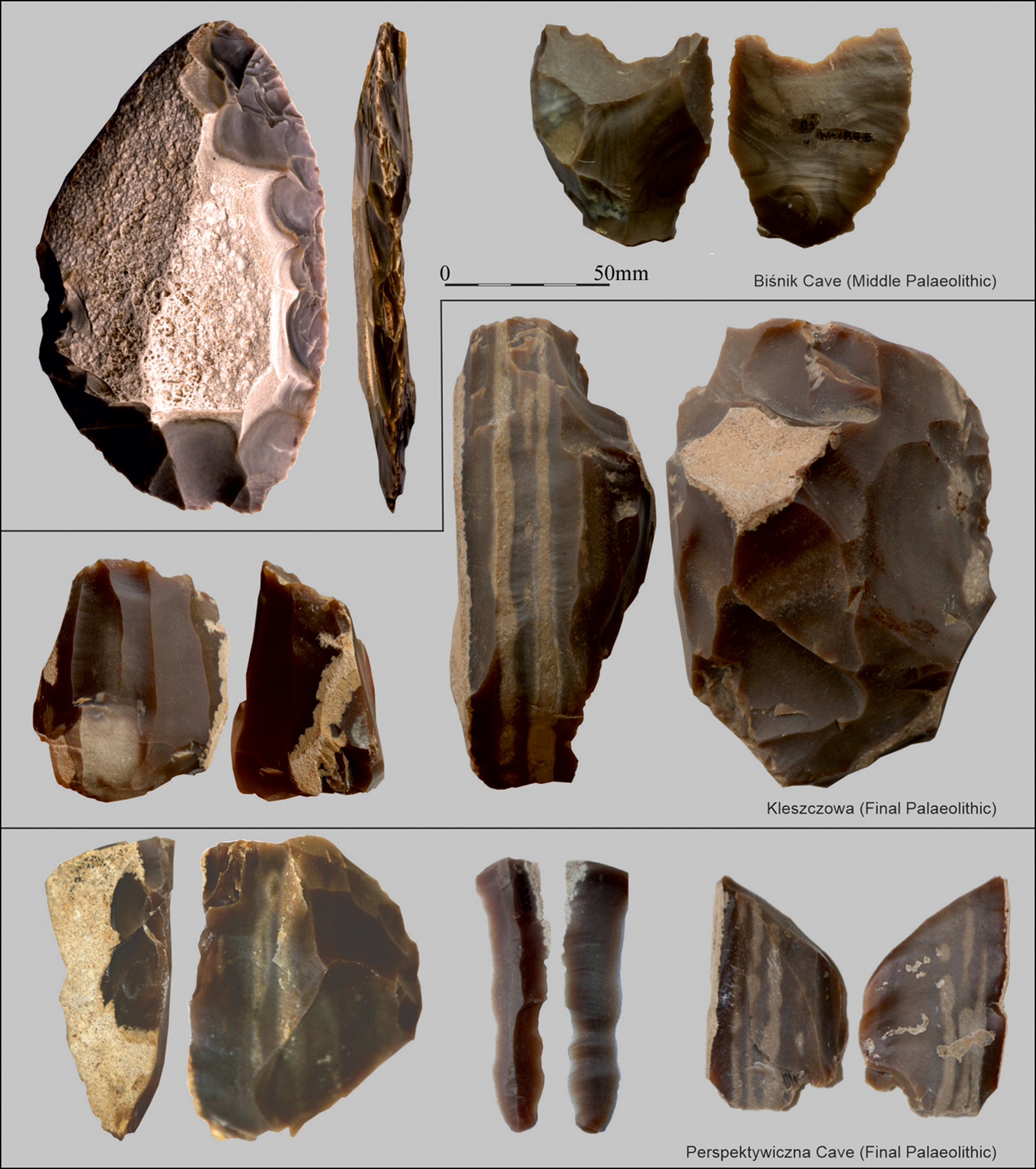
Figure 1. Selected lithic artefacts of chocolate flint from the sites in the Kraków-Częstochowa Upland area (photographs by M. Sudoł-Procyk).
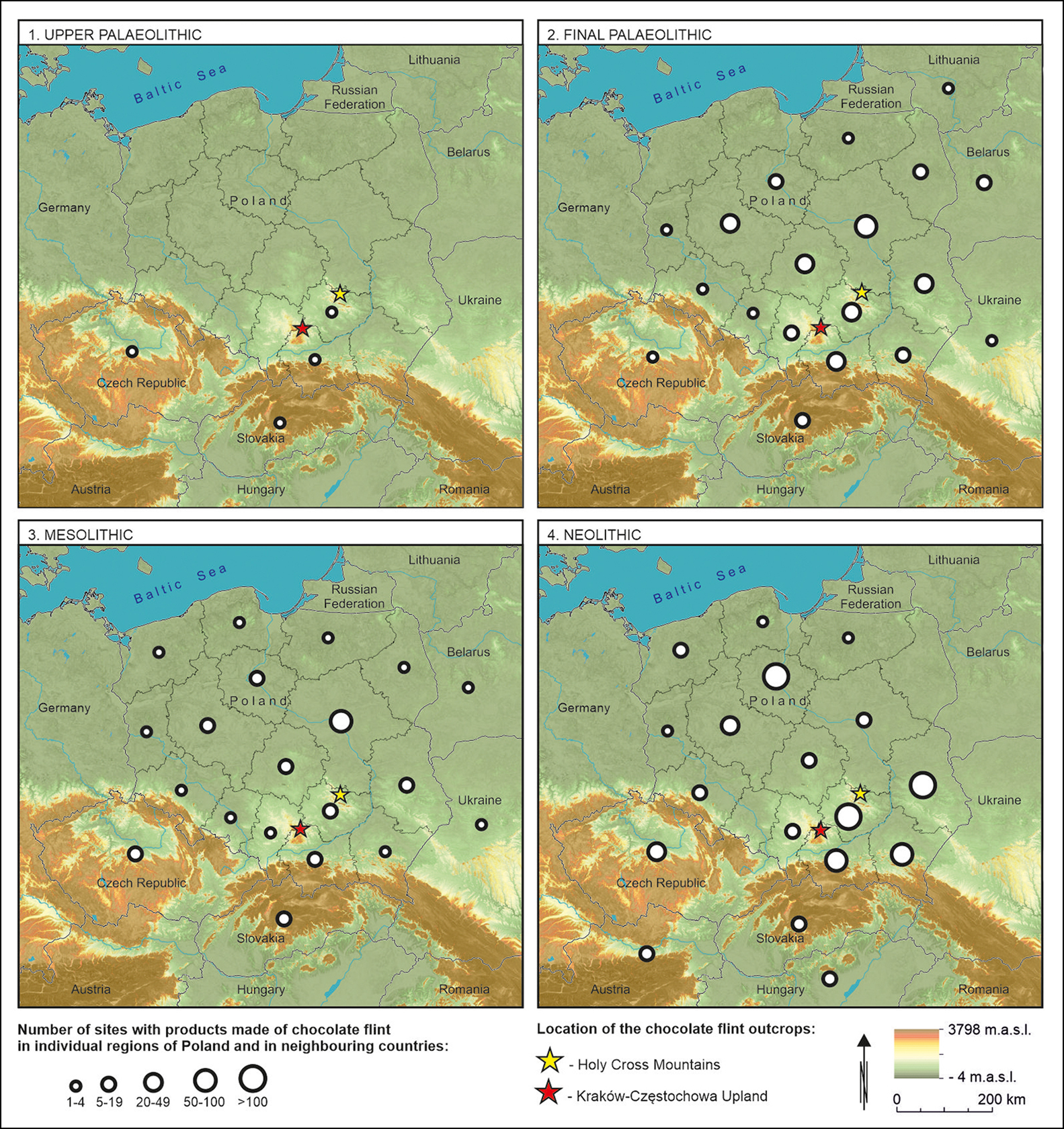
Figure 2. Chocolate flint deposits and number of sites with artefacts of this raw material in regions of Central Europe (figure by M. Skrzatek & M. Sudoł-Procyk).
The Chocolate Flint on the Kraków-Częstochowa Upland: Mining, Use and Distribution project, led by Magdalena Sudoł-Procyk, aims to undertake a detailed study of the spread of chocolate flint deposits in the Kraków-Częstochowa Upland area and the places of its exploitation, and to determine the role of this raw material in the prehistoric communities of Central Europe. These factors are particularly important for studies focused on the extent of the use of local raw material resources and those trying to understand the presence of material imported from distant sources in Stone Age site assemblages.
Methodology
The project applies multifaceted archaeological and geological research methods designed to recognise further chocolate flint outcrops in the area of the Kraków-Częstochowa Upland where this material was extracted and processed. Chocolate flint outcrops have been found on the eastern edge of the central part of the Kraków-Częstochowa Upland, in the Udorka Valley, near the village of Poręba Dzierżna. At present, this is the only known deposit of chocolate flint situated outside the Holy Cross Mountains. The Kraków-Częstochowa Upland has a monoclinal geological structure. We therefore expect that other chocolate flint-bearing outcrops will be found forming an elongated north-north-west to south-south-east belt along the eastern edge of the Kraków-Częstochowa Upland. Detailed geological mapping of these outcrops, together with studies of their geological and geomorphological context, will allow us to determine their accessibility in the past, and therefore the economic importance of these deposits for prehistoric societies.
Several prehistoric sites have been discovered in the vicinity of chocolate flint deposits within the Kraków-Częstochowa Upland area, including a flint mine and lithic workshops (Figure 1; Sudoł-Procyk et al. Reference Sudoł-Procyk, Budziszewski, Krajcarz, Jakubczak, Szubski, Werra and Woźny2018). The mine is situated in the Udorka Valley. The geomorphology of the outcrop has been extensively altered by prehistoric activity (also visible on lidar images; Figure 3a). Numerous pits—the remnants of the mining shafts—of at least four types are clustered in step-like zones on the valley side (Sudoł-Procyk et al. Reference Sudoł-Procyk, Budziszewski, Krajcarz, Jakubczak, Szubski, Werra and Woźny2018). Preliminary proxies based on stratigraphic premises and initial OSL and radiocarbon-dating (Sudoł-Procyk et al. Reference Sudoł-Procyk, Krajcarz, Malak and Werra2021) confirm that chocolate flint from this region (Figure 3b) was known and obtained by hunter-gatherer communities at least since the final Pleistocene and Early Holocene. The site will be thoroughly examined to obtain a fuller understanding of the nature of the mining facilities and their chronological and cultural context. Detailed archaeological surveys in the outcrop zones will reveal any more prehistoric sites situated in the vicinity of the deposits and potentially related to the exploitation and processing of chocolate flint.
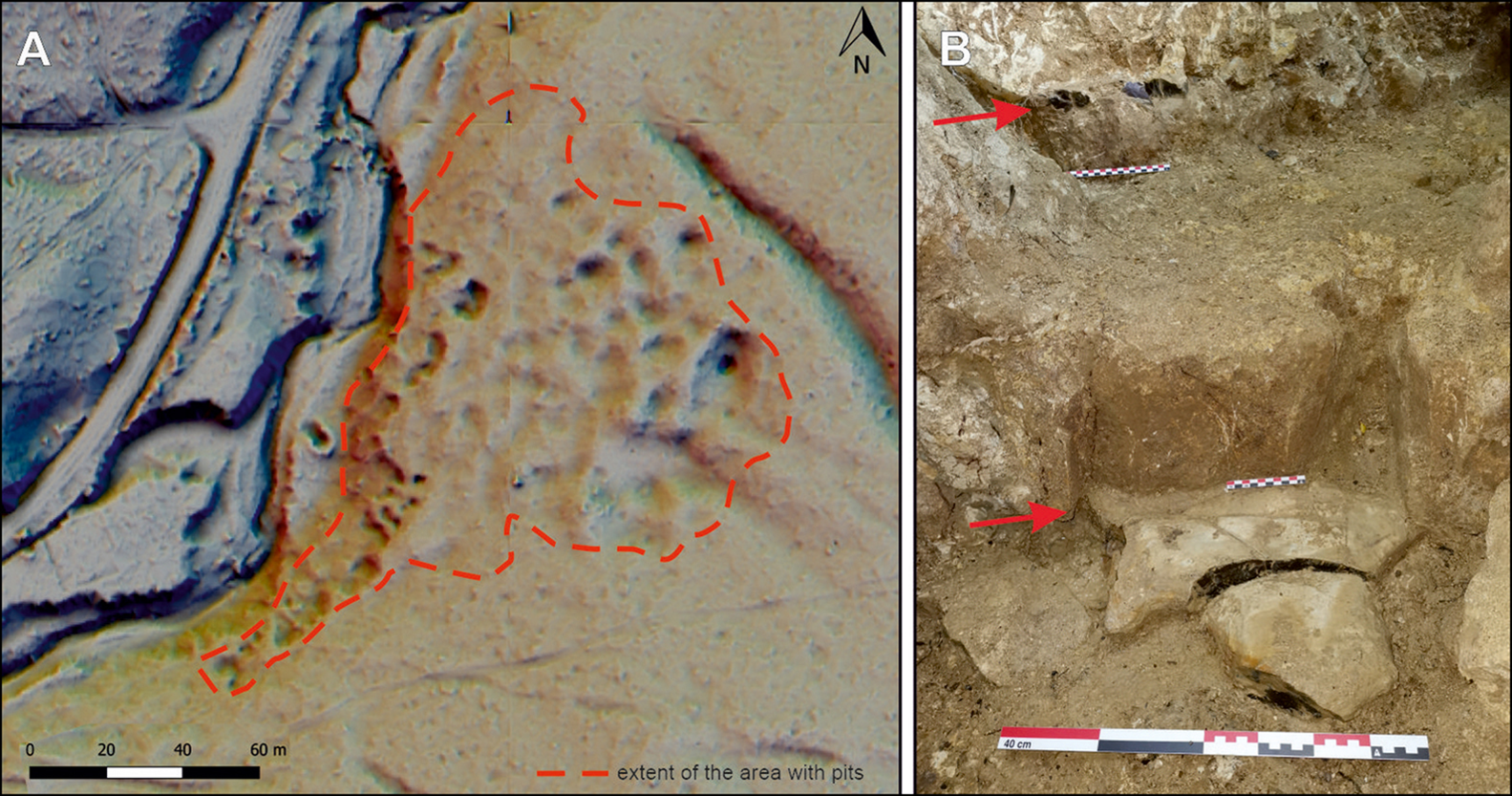
Figure 3. A) Lidar data displaying mining features within the outcrops of chocolate flint in the Udorka Valley, Kraków-Częstochowa Upland (after Sudoł-Procyk et al. Reference Sudoł-Procyk, Budziszewski, Krajcarz, Jakubczak, Szubski, Werra and Woźny2018); b) chocolate flint in Udorka Valley in situ (photograph by M. Sudoł-Procyk).
Crucial in understanding the role of chocolate flint in prehistoric exchange networks is mapping its distribution on archaeological sites both in the Kraków-Częstochowa Upland area and beyond, and in neighbouring countries (Germany, Czechia, Slovakia, Hungary, Austria, Ukraine, Belarus, Lithuania). In Poland sites with chocolate flint artefacts are known from almost all periods of prehistory (Figure 2). The exact number of sites, quantities of chocolate flint artefacts at these sites, and the character of these artefacts (knapped locally or imported as finished products), however, has never been fully evaluated. A database will be developed to record details of all chocolate flint artefacts from archaeological sites in Central Europe. This will allow a reconstruction of the prehistoric networks of chocolate flint distribution.
The efficacy of the database rests on accurate identification of chocolate flint among other silicites, and the ability to determine whether chocolate flint artefacts originate from the Holy Cross Mountains or Kraków-Częstochowa Upland sites. The success of the multi-layered chert-sourcing approach, used previously for chert materials from other parts of Europe (Brandl et al. Reference Brandl, Martinez, Hauzenberger, Filzmoser, Nymoen and Mehler2018), makes it an ideal method for this task. The multi-layered chert-sourcing approach combines macroscopic grouping (by colour, rock texture and granularity), stereomicroscopic testing for group consistency (examining individual microfacies, revealing similar or dissimilar depositional environments), and geochemical analyses using LA-ICP-MS (laser ablation inductively coupled mass spectrometry). LA-ICP-MS allows for the detection of main-, trace- and ultra-trace element concentrations, which reflect past seawater chemistry, indicative of the very specific source conditions of the siliceous rocks. Geochemical results can then be statistically treated with compositional data analysis to achieve optimal clustering and therefore precise provenance information (Figure 4).
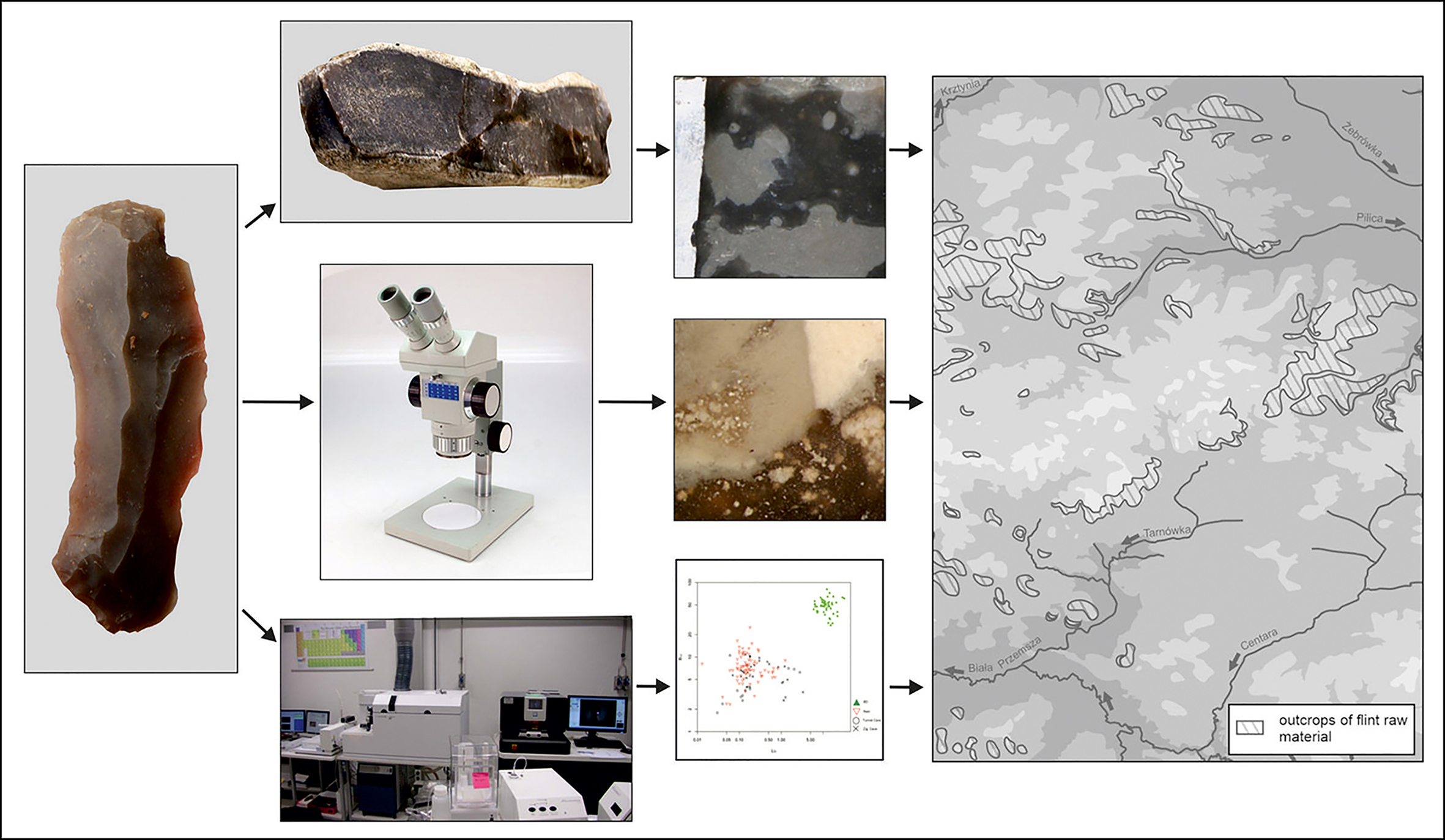
Figure 4. Multi-layered chert-sourcing approach: methodology diagram (photographs by M. Brandl and M. Sudoł-Procyk; figure by M.T. Krajcarz).
Conclusions
Accurate identification of chocolate flint from the Kraków-Częstochowa Upland area, which is macroscopically similar to that known from the Holy Cross Mountains (Schild Reference Schild1971; Krajcarz et al. Reference Krajcarz, Krajcarz, Sudoł and Cyrek2012), may provide much-needed verification of the current state of knowledge about the past distribution of this raw material. The Kraków-Częstochowa Upland outcrops might have been a particularly important source of chocolate flint for the Central European regions situated to the south and west—closer to the Kraków-Częstochowa Upland than to the Holy Cross Mountains deposit area; this could include places such as Silesia, Bohemia, Moravia, Slovakia, Bavaria, Austria or the Pannonian Basin. The identification and detailed investigation of lithic materials from archaeological sites in these regions will help to reveal the importance of both the Kraków-Częstochowa Upland and Holy Cross Mountains chocolate flint deposit areas and their wider significance in the Central European prehistoric economy.
Funding statement
The Chocolate Flint on the Kraków-Częstochowa Upland: Mining, Use and Distribution project is financed by a grant from the National Science Centre, Poland (2018/30/E/HS3/00567).


